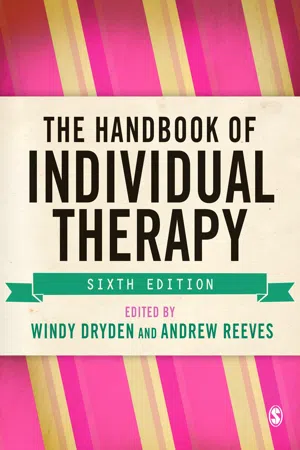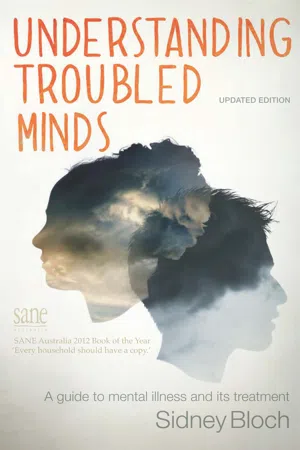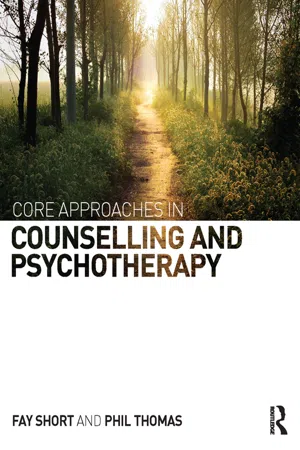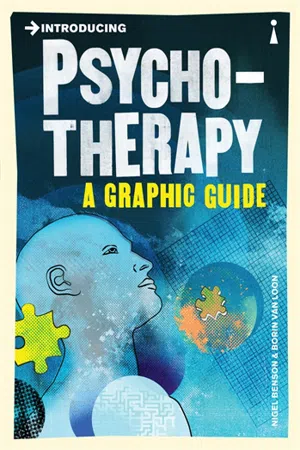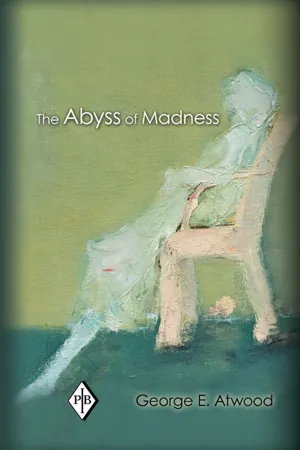Psychology
Psychotherapy
Psychotherapy is a form of treatment that involves talking with a trained therapist to address emotional, behavioral, and psychological challenges. It aims to help individuals understand their thoughts, feelings, and behaviors, and develop coping strategies to improve their mental well-being. Psychotherapy can be conducted through various approaches, such as cognitive-behavioral therapy, psychodynamic therapy, and humanistic therapy.
Written by Perlego with AI-assistance
Related key terms
6 Key excerpts on "Psychotherapy"
- eBook - ePub
- Windy Dryden, Andrew Reeves, Windy Dryden, Andrew Reeves(Authors)
- 2013(Publication Date)
- SAGE Publications Ltd(Publisher)
Psychology itself appeared as a technical term in 1748 and even then had overtones associating it with ‘soul’. Psychology has of course had its internal battles over identity and has moved significantly from its early insistence that it should scientifically exclude subjectivity. What we generally mean by ‘psychological therapy’ is an essentially talking-and-listening form of help that does not primarily utilise medical or physical means. While this could broadly include any spiritual or philosophical concepts and techniques (these are, after all, not medical or physical), it tends not to. Since psychology is promoted as a scientific discipline, clinical psychology, and latterly counselling psychology, have been advanced as applied scientific professions, in turn suggesting a superiority over earlier religious and philosophical traditions of helping people with their problems in living.3 CURRENT SOCIOCULTURAL CONTEXTS OF THERAPY IN BRITAINCushman’s (1995) seminal text on the historical development of Psychotherapy within the American context remains highly instructive but no directly comparable British text exists. Cushman’s analysis problematises the rise of the peculiarly Western sense of self and Rose’s (1989) analysis of British trends in the rise of psychology and its influences on our sense of a private self has some resonances (see also Wright (2011) for an Australian-based but widely applicable view). Significantly, in spite of a decades-long tradition of couple counselling and group therapy, individual therapy remains by far the preferred choice. We were told by the authors of one piece of (market) research (BACP/FF, 2004) that 21 per cent of the British population had had some form of counselling or Psychotherapy and that up to 82 per cent of people would willingly have therapy if they thought they needed it. Previous estimates of the numbers experiencing therapy had been around 5 per cent at most and there may be reasons to doubt a figure as high as 21 per cent. Nevertheless, since the struggling 1970s, when counsellors and psychotherapists encountered a great deal of public and media resistance, acceptance has continued to grow. The visibility and accessibility of counsellors in many GP practices and Improving Access to Psychological Therapies (IAPT) schemes means that therapy is no longer perceived as an elitist, unaffordable or dubious activity but as potentially available and beneficial to the entire adult population. Availability has been buttressed by the presence of free counselling in many colleges and universities, employee assistance programmes and voluntary organisations such as Relate, Cruse and Mind. - eBook - ePub
Counseling and Psychotherapy
A Christian Perspective
- (Author)
- 2011(Publication Date)
- Baker Academic(Publisher)
Psychotherapy and Psychological Treatmentsa trained person who practices the artful application of scientifically derived principles of establishing professional helping relationships with persons who seek assistance in resolving large or small psychological or relational problems. This is accomplished through ethically defined means and involves, in the broadest sense, some form of learning or human development” (2004, 9, italics in original).More recently, David Barlow (2004, 2005, 2006) has attempted to differentiate Psychotherapy from psychological treatments, which may add more confusion rather than clarity to the already diverse definitions available for counseling and Psychotherapy. He suggests that “psychological treatments” should refer to those dealing primarily with pathology, while “Psychotherapy” should refer to treatments that address adjustment or growth (2006, 216). Psychological treatments are therefore those that are clearly compatible with the objectives of health-care systems that address pathology. He further stresses that the two activities of psychological treatment (which is more specific) and Psychotherapy (which is more generic) would not be distinguished based on theory, technique, or evidence, but only on the problems they deal with. He is aware that these are controversial recommendations. However, I believe Barlow’s (2006) recommendation is not only controversial, but it is also potentially confusing and may not really help to clarify the definition of terms. Examples of psychological treatments provided by Barlow include “assertive community treatment, cognitive-behavioral therapy, community reinforcement approaches, dialectical behavior therapy, family focused therapy, motivational interviewing, multisystemic interpersonal therapy, parent training(for externalizing disorders in children), personal therapy for schizophrenia, and stress and pain management procedures - eBook - ePub
Understanding Troubled Minds Updated Edition
A guide to mental illness and its treatment
- Sidney Bloch(Author)
- 2014(Publication Date)
- Melbourne University Press Digital(Publisher)
Defining Psychotherapy is tricky for at least four reasons. Firstly, many psychological treatments are available, each with its own rationale and methods. Secondly, however well planned, these treatments are to a varying extent unpredictable in their application. The reasons for this are obvious once you think about the nature of the process. Psychotherapy is influenced by many unique features, among them the patient’s type of personality, the presenting problems, motivation for change and capacity for reflecting about oneself. Thirdly, treatment is also influenced by therapist’s personal qualities and the values they espouse; in this regard, the therapist–patient relationship is all-important. Finally, goals of treatment range from relief of symptoms (as in behaviour therapy) to radical personality change (as in insight-oriented approaches like psychoanalysis).The task of definition is eased by referring to ‘the psychotherapies’, since we are concerned with an array of treatments, applied for varied purposes. (Counselling is related to Psychotherapy but usually regarded as distinct from it—I shall address it briefly later in the chapter). All psychotherapies involve two foundational features. The first is a relationship between a trained health professional (psychiatrist, psychologist and social worker are the principal groups) and a person needing help to deal with psychological distress (for example, depression, anxiety, guilt, poor self-esteem, unresolved grief) and disturbed functioning (for example, failure in maintaining intimate relationships, marital strife, poor coping with stress). The second feature is the planned, systematic application of specific psychological principles.Factors that unite the therapies
This succinct definition covers all psychotherapies, although the person’s particular difficulties, and the psychological principles applied vary considerably. On the other hand, certain features unite the psychotherapies. These common basic factors were originally formulated by Jerome Frank, a pioneering Psychotherapy researcher, in the early 1970s. Given the systematic studies of his group, we can conclude confidently that these factors are necessary but not sufficient for the practice of the psychotherapies, and that we also need to incorporate additional psychological principles. - eBook - ePub
- Fay Short, Phil Thomas(Authors)
- 2014(Publication Date)
- Routledge(Publisher)
Cognitive approach (revolution)Therapy
Therapy could be described as the practical application of an approach to support human growth and development Several different therapies can operate under a single approach and each therapy may apply the theories within the approach in a slightly different manner All the therapies under a single approach will share a common philosophy of human nature For example, person-centred therapy and existential therapy both operate under the humanistic approach Some therapies can operate under two or more approaches by combining the theories within the approach in a novel manner These therapies will combine the principles of human nature from two or more different approaches For example, cognitive-behaviour therapy combines the cognitive approach with the behavioural approach Some therapies do not operate under any approach, but instead select specific techniques from various different therapies that sit under different approaches dependent on the situation and clientThese therapies argue that all the approaches hold some fundamental truths about human nature so they take the most relevant and appropriate parts from each without specifically adhering to all the principles of anyFor example, multimodal therapy does not subscribe to the principles of any one approachModel
Model could be described as a framework for applying a therapy Models usually involve steps or processes which can be followed by the therapist irrespective of his or her chosen approach and therapy For example, Egan’s skilled helper model (Egan, 2007) - eBook - ePub
Introducing Psychotherapy
A Graphic Guide
- Nigel Benson, Borin Van Loon(Authors)
- 2015(Publication Date)
- Icon Books Ltd(Publisher)
The ability to form and maintain mutually rewarding relationship is important to most people. Some therapies have been developed that directly involve groups as a central aspect of the treatment ...Group Therapy
The concept of treating people in groups rather than individually – encouraging group members directly to help each other – was developed mostly by humanistic therapists, especially Carl Rogers. Group therapy can also be conducted using any of the five main approaches described so far. Psychodynamic therapy, for example, includes the group techniques of psychodrama and transactional analysis , while humanistic therapy includes encounter groups and sensitivity training.Psychodrama
Psychodrama was invented by the psychoanalyst Moreno in 1946 to help people resolve the conflicts that cause them anxiety.Each person in the group takes on a role or auxiliary ego with whom the central character or protagonist has to improvise. For example, a person who has problems with an authority figure may act out a childhood scene with family members...You’re my father, why are you hitting me? It’s for your own good, my son!Variations within Psychodrama
Role-reversal – actors swap roles.Doubling – two people act out the same role.Mirroring – group members copy the protagonist’s behaviour, often exaggerating it to make the point.They goal is to reveal to the protagonist why he or she is behaving in a particular way.The therapeutic aim of psychodrama is to ...(a) help prevent destructive and irrational behaviour in everyday life(b) enable expression of feelings which are difficult to describe(c) encourage people to reveal the roots of their problems.Other similar therapies include primal therapy and re-birthing.Transactional Analysis
Another psychodynamic group technique is Transactional Analysis or TA, described in the popular book Games People Play (1964) by Eric Berne. The term refers to the interactions or transactions between people in a paired dialogue – husband and wife, siblings, employer and employee, doctor and patient. At any point in time, each person can be analysed using structural analysis according to three types of behaviour or ego states - eBook - ePub
- George E. Atwood(Author)
- 2012(Publication Date)
- Routledge(Publisher)
implicated might seem to indicate that a crime of some sort has occurred. The things that happen in what is called Psychotherapy or psychoanalysis often enough are crimes, emotional crimes committed against those we are entrusted to help. But that is not the connotation I want to highlight. It is more the idea that the imprint of the therapist’s subjectivity, of his or her personality, is everywhere present in the psychotherapeutic process. Psychotherapy, far from being any sort of procedure that is administered from a place of detachment, is always a dialogue between two personal universes, one that transforms both.On more than one occasion at psychoanalytic conferences, I have been asked how it is then that we are to distinguish which of the people involved in an analysis is the patient. I become impatient with such questions, and once suggested that one can see which is which by determining which one is crying. Of course, that doesn’t work when the patient does something so upsetting that the therapist breaks into tears. A psychotherapeutic dialogue, if it is in any measure successful, always illuminates and transforms the worlds of both of the people involved, and as far as I am concerned, this is actually self-evident.Consider again my early clinical experience with Grace, my religious patient who visualized herself as part of the Holy Trinity. Her journey of healing utterly transformed my understanding of the whole realm of severe psychological disturbances and of the potential of Psychotherapy to address them. Recall her promise that she would raise me up from someone small and weak into a position of strength and power. She certainly succeeded in doing that. I could also speak of the effect of witnessing her struggle with her father’s suicide as her mourning process unfolded. I could not follow these developments without a corresponding opening up of my own early experiences of trauma and loss. To see someone coming to the truth of his or her life is, inevitably, to be brought closer to the truth of one’s own. In the golden age of Psychotherapy practice that is to come, this idea will be axiomatic. All the phenomena of Psychotherapy will be understood as taking place within an intersubjective field, one that creates a constitutive context for the experiences and actions of both analyst and patient.
Learn about this page
Index pages curate the most relevant extracts from our library of academic textbooks. They’ve been created using an in-house natural language model (NLM), each adding context and meaning to key research topics.
